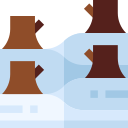Impacts of Temperature Rise on Forest Health
Today’s chosen theme: Impacts of Temperature Rise on Forest Health. Explore how heat reshapes canopies, water cycles, pests, fire, and biodiversity, and discover practical actions you can take. Share your observations and subscribe to stay connected with a community protecting forests under rising temperatures.
Heat Stress: The First Cracks in the Canopy
On scorching weeks, leaves curl, scorch, and close stomata to conserve water. That protective shutdown hampers photosynthesis, starves tissues, and invites decline. Noticing early canopy thinning? Tell us where and when; your notes help map heat stress hotspots.

Water, Drought, and the Forest's Thirst
01
When heat dries upper horizons, mycorrhizae lose contact with moist pores, weakening nutrient exchange. Expect dustier forest floors, hydrophobic crusts, and streams shrinking to isolated pools. Log your local stream’s lowest summer flow; crowd-sourced records sharpen our drought-heat impact maps.
02
Extreme heat speeds cavitation, air bubbles blocking xylem, and shortens nightly recovery windows. Repeated episodes can push trees past a survival threshold. Have ring widths narrowed after recent heatwaves near you? Share cores, photos, or impressions to compare with our annual datasets.
03
Small actions can buffer heat: retaining coarse woody debris, protecting understory shrubs, and avoiding bare-soil disturbance. These create cooler microsites for seedlings. What microclimate tricks work in your community forest? Comment, and subscribe for field-tested protocols you can adopt safely.
Bark Beetle Booms in Warm Winters
Milder cold seasons let beetles overwinter successfully and complete extra generations. Heat-stressed pines emit signals that attract attack. Have you spotted pitch tubes or red-needled 'ghost' trees after a hot spell? Pin your sightings; collective alerts support rapid management responses.
Fungi, Rusts, and Novel Disease Fronts
Higher temperatures expand the suitable range for pathogenic fungi and alter leaf wetness periods. This reshapes infection windows and severity. Gardeners and hikers, track unusual cankers or spots on favorite trails, then subscribe for identification guides and seasonal risk briefings.
Predators, Allies, and Biological Balance
Heat also shifts parasitoids and predators that keep pests in check. Conservation of habitat complexity helps allies persist. Which native birds or insects are active around recent outbreaks near you? Share observations to build a richer picture of warming-altered ecological balances.


Warmer springs can prompt earlier budburst, yet pollinators or protective frosts may not align. That mismatch reduces reproduction and resilience. What timings have shifted in your woods? Add dates, elevations, and species to help map phenological change linked to heat.
Shifting Ranges and Changing Casts of Species
Voices from the Forest: Stories of Heat and Hope
On a blistering August patrol, a veteran ranger noticed beetle galleries on trees that had withstood decades. Heat had tipped the balance. Her field notes inspired neighbors to monitor weekly. Share your turning-point moment; your story might spark another community’s vigilance.
From Concern to Action: What You Can Do Now
Tend Cooler Microhabitats
Join workdays that preserve understory shade, protect fallen wood, and limit soil exposure near trails. These steps moderate heat at seedling height. Comment with groups to join, and subscribe for monthly actions aligned with temperature-related forest health priorities.


Support Climate-Smart Policies
Speak up for thinning where appropriate, prescribed fire, and protection of climate refugia like north-facing slopes. Your voice helps align management with science. Tell us which policies you’re advocating locally so we can share templates shaped by warming realities.
